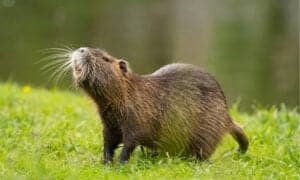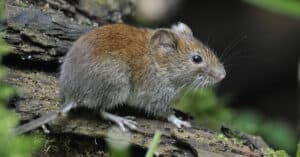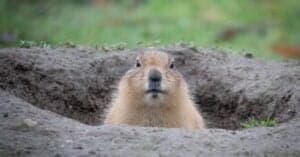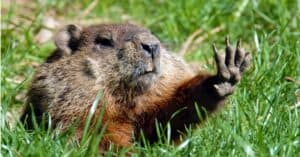Marmot Vs Groundhog: 6 Differences Explained
@media (min-width: 481px) {
.mobile-top-content {
display: none;
}
}
#mobileTopContentCTACarouselControls { overflow: hidden; text-overflow: ellipsis; white-space: nowrap; }
.mobile-top-content .more { color: #fff; }
.mobile-top-content a { color: #fff; text-decoration: underline; }
.mobile-top-content a:hover { color: #fff; text-decoration: underline; }
@media (max-width: 480px) {
.mobile-top-content {
background-color: #06a10b;
color: #fff;
text-align: center;
/*height: 60px;
padding-top:5px;*/
font-size:80%;
/* display: block; */
margin: 0px -30px;
}
}
Marmots and groundhogs look incredibly similar and can be easily confused at first glance. Thankfully, there are a few key differences that can help us distinguish the two. Let’s explore these differences and learn how the battle of Marmot Vs. Groundhog actually shows us how unique they really are! Here are the 6 most notable differences between marmots and groundhogs.
Marmots are members of the squirrel family, clocking in as the heaviest members in the world! Within the marmot family are 15 unique species, one of which is the groundhog. Essentially, all groundhogs are marmots, but not all marmots are groundhogs. Today, however, we are going to be covering a common distinction between groundhogs and another common species of marmot known as the yellow-bellied marmot.
The 6 Main Differences Between Marmots and Groundhogs
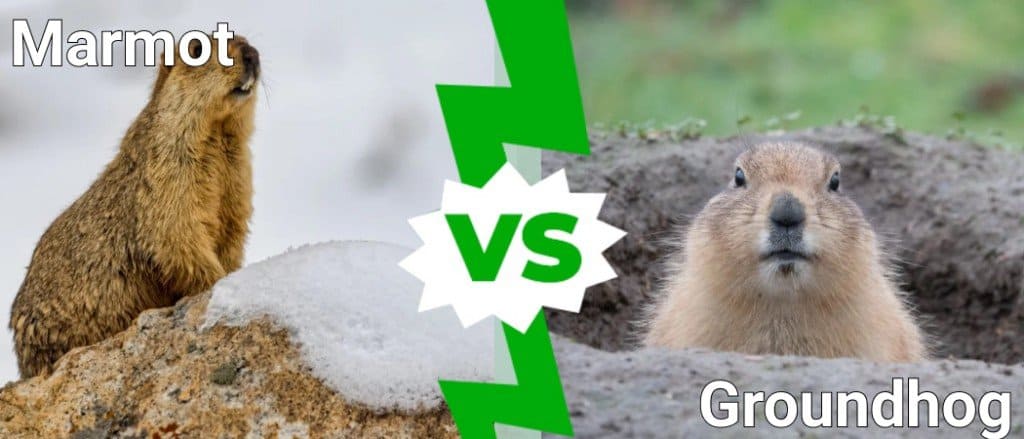
A-Z-Animals.com
The main difference between groundhogs and marmots is that groundhogs are slightly larger and are less colorful. In addition, yellow-bellied marmots live in the Western United States while groundhogs are more widespread. Groundhogs will also burrow in more varied environments and are less social than marmots.
Let’s dive into more details on each of these differences!
Marmot Vs Groundhog: Size
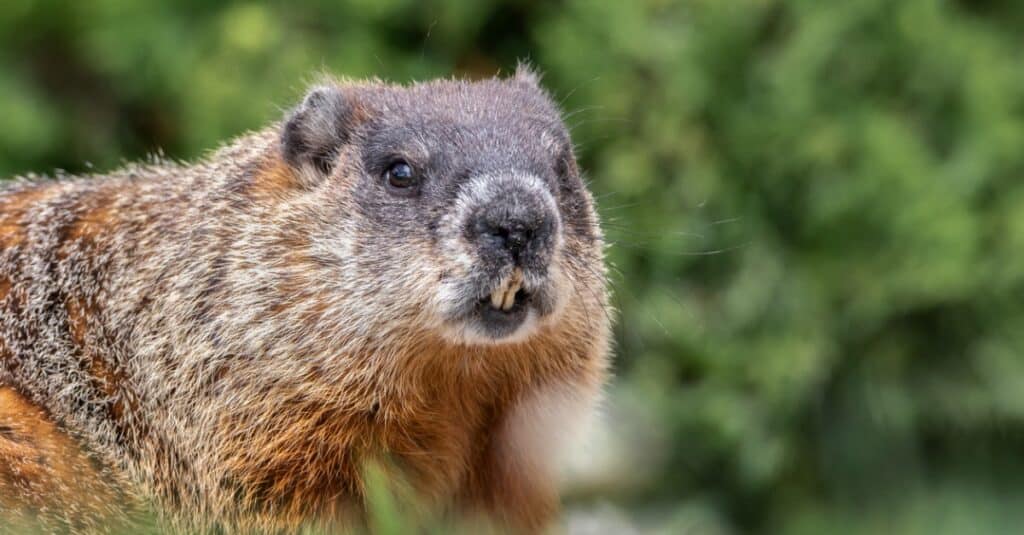
iStock.com/Jean Landry
Yellow-bellied marmots are smaller than groundhogs, but not by much. Generally, they only grow to 27 inches long and generally weigh between 3 and 9 lbs.
Groundhogs aren’t just large rodents, they are some of the largest species of marmot in the world. They can be up to 20 inches long and weigh between 6-12 lbs, with some individuals getting even larger. Groundhogs reach sexual maturity between 1-2 years in the wild and generally have a lifespan of 3 to 5 years, although in captivity they can live closer to 15 years.
To reach these sizes, both marmots and groundhogs primarily eat plants. However, marmots will also eat eggs and insects in addition to grasses, berries, seeds, and roots. Groundhogs primarily eat vegetation like grasses and flowing plants, but have been seen eating insects, mollusks, and even small birds!
Marmot Vs Groundhog: Coloration

Egoreichenkov Evgenii/Shutterstock.com
The easiest way to identify a yellow-bellied marmot is from, well, its yellow belly. They have distinct yellow fur across their chest and stomach. Their backs, head, and tail are covered in brown or grey fur, with some individuals having a white spot on their foreheads.
Groundhogs are more variable in their color possibilities but are overall more consistent across their body in whatever color they are. They can range from a grey-brown to a cinnamon brown across their entire bodies. Their snouts are generally the only place where their coloration changes, but it mostly depends on the individual.
Marmot Vs Groundhog: Range
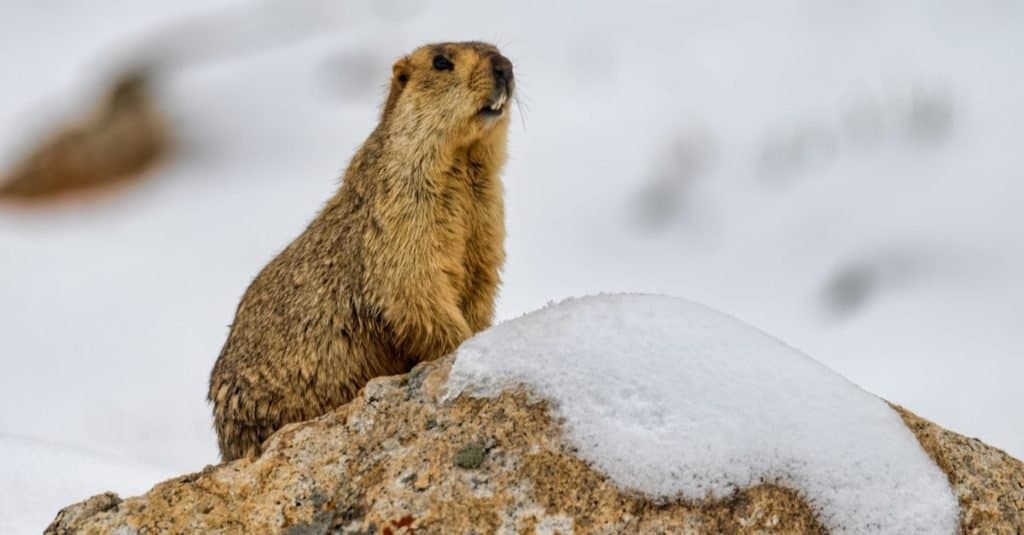
Kamal Hari Menon/Shutterstock.com
Yellow-bellied marmots have a relatively small range when compared to the groundhog. They are specialized for mountainous environments, almost entirely being found at elevations higher than 2,000 feet. The most common places to find yellow-bellied marmots are in meadows and prairies across the Rocky Mountains and the Sierra Nevadas.
Groundhogs are widespread across much of the United States. They are found east of the Mississippi, as far south as Alabama, and as far north as the Hudson Bay. They do spread west, but only in the northern regions of Canada. Groundhogs are usually the most common marmots to interact with humans because their range and preferred habitat coincide with human population centers.
Marmot Vs Groundhog: Burrows
All ground squirrels have burrows, but marmots may just be the masters of them. Yellow-bellied marmots live in rocky soil, often with massive boulders present. As an adaptation, they often construct their dens and burrows under these large boulders, allowing them to escape from predators without the potential of being dug out. They are also known for hiding from predators in rock piles.
Groundhogs also construct burrows, only they aren’t as picky as yellow-bellied marmots are. Generally, they will burrow near woodland edges and in well-drained soil. Burrows can have multiple chambers, all designed for a specific use, things like nurseries, bathrooms, and more.
Marmot Vs Groundhog: Social habits
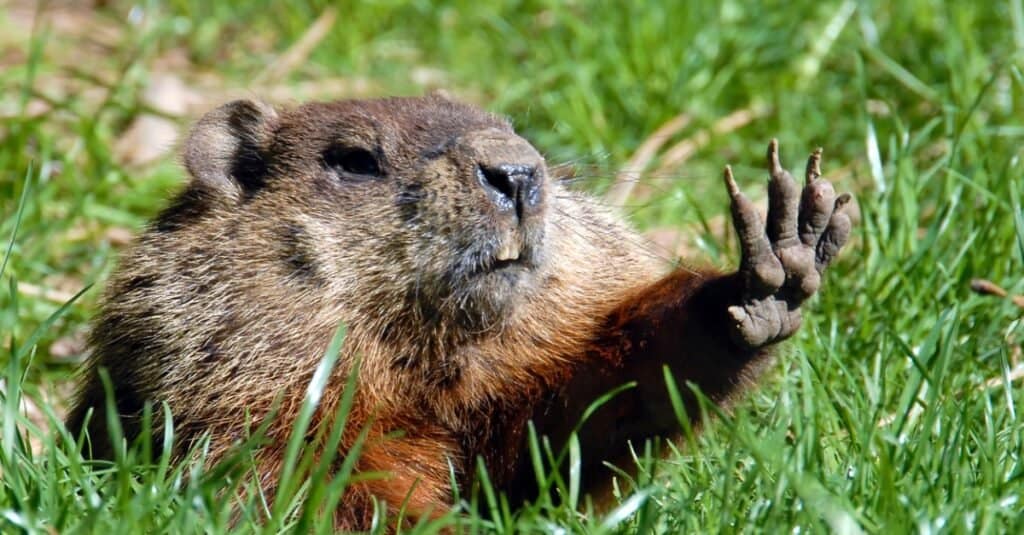
iStock.com/mirecca
All marmot species are extremely social and intelligent animals. Yellow-bellied marmots form complex social relationships and usually congregate in groups of up to 20 individuals. These colonies have different male/female relationships and even have a whistling communication system.
Groundhogs are also social; they are just the most solitary of all the marmot species. Most family groups consist of a breeding pair and the young from the last few litters. Yellow-bellied marmots are more social than most groundhogs.
Marmot Vs Groundhog: Status as a pest
Yellow-bellied marmots are considered pests in some places, but their relative isolation keeps them from being a real nuisance to farmers or builders.
Groundhogs, on the other hand, are famous pests. They often burrow near farms and gardens and have no issue with eating massive amounts of crops. Additionally, their burrows can often cause structural damage to buildings and roads.
FAQs (Frequently Asked Questions)
Are groundhogs larger than marmots?
When it comes to size, the groundhog is slightly larger than the yellow-bellied marmot. Groundhogs can be up to 20 inches long and weigh between 6-12 lbs. Yellow-bellied marmots, on the other hand, can grow to 27 inches long and generally weigh between 3 and 9 lbs.
What differences do groundhogs and marmots have in appearance?
Coloration is one of the easiest ways to tell the difference between a yellow-bellied marmot and a groundhog. Yellow-bellied marmots are known for their yellow coloration across their undersides and into their snouts. Their backs and tails are reddish-brown, and they often have a white spot on their forehead. Groundhogs are less colorful, often having a flat reddish-brown or brown coloring across their entire body.
Do marmots and groundhogs live in the same locations?
Location is also a great way to tell the difference between yellow-bellied marmots and groundhogs. Yellow-bellied marmots exclusively live in the western United States, primarily in the Rocky Mountains and the Sierra Nevadas, often over elevations of 2,000 feet. Groundhogs are more widespread, with a range in the eastern US, starting in Alabama and going north all the way through most of Canada.
Where do marmots and groundhogs burrow?
Yellow-bellied marmots have adapted their burrows to their rocky environments, often burrowing under large rocks to prevent predators from digging them out. Groundhogs are less picky and will often burrow under buildings, through fields, and into farms.
Are marmots or groundhogs more social?
Marmots, as a group, are generally social animals. The main difference between these two species, however, is the colony size. Yellow-bellied marmots live in colonies of up to 20 members, while groundhogs rarely exceed colonies of 10-15.
Are marmots or groundhogs considered pests?
Many marmot species are considered pests, but few are as widespread and destructive as groundhogs. Due to the isolated habitat that yellow-bellied marmots live, they only occasionally interfere with human farms or structures. Groundhogs, however, will eat through large portions of crops and are known to cause structural damage to buildings across much of the eastern US.
More from A-Z Animals
.more-snake-card-image { max-height:140px !important; }
@media (min-width: 481px) {
.mobile-top-content {
display: none;
}
}
#mobileTopContentCTACarouselControls { overflow: hidden; text-overflow: ellipsis; white-space: nowrap; }
.mobile-top-content .more { color: #fff; }
.mobile-top-content a { color: #fff; text-decoration: underline; }
.mobile-top-content a:hover { color: #fff; text-decoration: underline; }
@media (max-width: 480px) {
.mobile-top-content {
background-color: #06a10b;
color: #fff;
text-align: center;
/*height: 60px;
padding-top:5px;*/
font-size:80%;
/* display: block; */
margin: 0px -30px;
}
}
Marmots and groundhogs look incredibly similar and can be easily confused at first glance. Thankfully, there are a few key differences that can help us distinguish the two. Let’s explore these differences and learn how the battle of Marmot Vs. Groundhog actually shows us how unique they really are! Here are the 6 most notable differences between marmots and groundhogs.
Marmots are members of the squirrel family, clocking in as the heaviest members in the world! Within the marmot family are 15 unique species, one of which is the groundhog. Essentially, all groundhogs are marmots, but not all marmots are groundhogs. Today, however, we are going to be covering a common distinction between groundhogs and another common species of marmot known as the yellow-bellied marmot.
The 6 Main Differences Between Marmots and Groundhogs

A-Z-Animals.com
The main difference between groundhogs and marmots is that groundhogs are slightly larger and are less colorful. In addition, yellow-bellied marmots live in the Western United States while groundhogs are more widespread. Groundhogs will also burrow in more varied environments and are less social than marmots.
Let’s dive into more details on each of these differences!
Marmot Vs Groundhog: Size

iStock.com/Jean Landry
Yellow-bellied marmots are smaller than groundhogs, but not by much. Generally, they only grow to 27 inches long and generally weigh between 3 and 9 lbs.
Groundhogs aren’t just large rodents, they are some of the largest species of marmot in the world. They can be up to 20 inches long and weigh between 6-12 lbs, with some individuals getting even larger. Groundhogs reach sexual maturity between 1-2 years in the wild and generally have a lifespan of 3 to 5 years, although in captivity they can live closer to 15 years.
To reach these sizes, both marmots and groundhogs primarily eat plants. However, marmots will also eat eggs and insects in addition to grasses, berries, seeds, and roots. Groundhogs primarily eat vegetation like grasses and flowing plants, but have been seen eating insects, mollusks, and even small birds!
Marmot Vs Groundhog: Coloration

Egoreichenkov Evgenii/Shutterstock.com
The easiest way to identify a yellow-bellied marmot is from, well, its yellow belly. They have distinct yellow fur across their chest and stomach. Their backs, head, and tail are covered in brown or grey fur, with some individuals having a white spot on their foreheads.
Groundhogs are more variable in their color possibilities but are overall more consistent across their body in whatever color they are. They can range from a grey-brown to a cinnamon brown across their entire bodies. Their snouts are generally the only place where their coloration changes, but it mostly depends on the individual.
Marmot Vs Groundhog: Range

Kamal Hari Menon/Shutterstock.com
Yellow-bellied marmots have a relatively small range when compared to the groundhog. They are specialized for mountainous environments, almost entirely being found at elevations higher than 2,000 feet. The most common places to find yellow-bellied marmots are in meadows and prairies across the Rocky Mountains and the Sierra Nevadas.
Groundhogs are widespread across much of the United States. They are found east of the Mississippi, as far south as Alabama, and as far north as the Hudson Bay. They do spread west, but only in the northern regions of Canada. Groundhogs are usually the most common marmots to interact with humans because their range and preferred habitat coincide with human population centers.
Marmot Vs Groundhog: Burrows
All ground squirrels have burrows, but marmots may just be the masters of them. Yellow-bellied marmots live in rocky soil, often with massive boulders present. As an adaptation, they often construct their dens and burrows under these large boulders, allowing them to escape from predators without the potential of being dug out. They are also known for hiding from predators in rock piles.
Groundhogs also construct burrows, only they aren’t as picky as yellow-bellied marmots are. Generally, they will burrow near woodland edges and in well-drained soil. Burrows can have multiple chambers, all designed for a specific use, things like nurseries, bathrooms, and more.
Marmot Vs Groundhog: Social habits

iStock.com/mirecca
All marmot species are extremely social and intelligent animals. Yellow-bellied marmots form complex social relationships and usually congregate in groups of up to 20 individuals. These colonies have different male/female relationships and even have a whistling communication system.
Groundhogs are also social; they are just the most solitary of all the marmot species. Most family groups consist of a breeding pair and the young from the last few litters. Yellow-bellied marmots are more social than most groundhogs.
Marmot Vs Groundhog: Status as a pest
Yellow-bellied marmots are considered pests in some places, but their relative isolation keeps them from being a real nuisance to farmers or builders.
Groundhogs, on the other hand, are famous pests. They often burrow near farms and gardens and have no issue with eating massive amounts of crops. Additionally, their burrows can often cause structural damage to buildings and roads.


